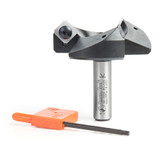Save time and money, utilize your CNC machine to sand for you!
This CNC orbital sanding tool is designed to use with any 4” sanding disc (not included) according with the finish required. Also for use with Router Sled.
- Industrial quality
- 3.50 orbit value
- 4" sanding disc sold separately
The lower the grit numbers, the coarser the disc will be, and the higher the grit, the finer it will be.
- 40 grit: Coarse.
- 80 grit: Medium.
- 100 grit: Medium.
- 120 grit: Fine.
- 220 grit: Fine.
- 440 grit: Extra Fine.
Knowing which grit sandpaper to use depends on the type of job and what step in the process you are in.
Set Up at the CNC Machine
- Check the tool Flexibility movement it should be about 3mm.
- Install the IN-SAND™ at the tool holder or directly at the spindle.
- You can measure the IN-SAND™ on the machine measuring device or simply update manually the tool length from pad surface, The diameter should be 4-11/32” (110mm) and not 3-15/16” (100mm) of the orbital movement of the pad.
- The sanding power is defined by the “Milling Depth” the max depth is 1/8” (3.17mm) but our recommendation is 8,000 RPM and milling depth of 0.3 – 0.5mm.
- Use the Option of “Milling Pockets” to control the tool path.
 WARNING! The max RPM for this orbital sander is 12,000 RPM. Working with higher rotation speed can cause damage to the machine spindle.
WARNING! The max RPM for this orbital sander is 12,000 RPM. Working with higher rotation speed can cause damage to the machine spindle.
 WARNING!
WARNING! The max RPM for this orbital sanding is 12,000. Working with higher rotation speed can cause damage to the machine spindle.































